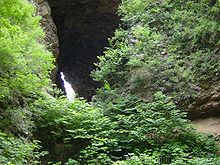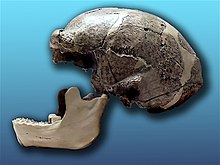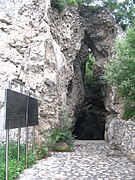Zhoukoudian
| Peking man's site in Zhoukoudian | |
|---|---|
|
UNESCO world heritage |
|

|
|
| Entrance to the world heritage site |
|
| National territory: |
|
| Type: | Culture |
| Criteria : | iii, vi |
| Surface: | 480 ha ha |
| Buffer zone: | 888 ha ha |
| Reference No .: | 449 |
| UNESCO region : | Asia and Pacific |
| History of enrollment | |
| Enrollment: | 1987 (session 11) |
Zhoukoudian ( Chinese 周口店 地区 , Pinyin Zhōukǒudiàn Dìqū ), formerly also Choukoutien or Chou K'ou Tien , is a suburb of the Fangshan District (房山区) of the Chinese capital Beijing . It is located about 42 km southwest of the city center. Zhoukoudian is known for the cave system located there .
Several caves gained importance through the discovery of fossil prehistoric humans and nearly 100 animal species. Among other things, the remains of around 45 so-called Peking people ( Homo erectus ), the fossils of Shandingdong people ("Upper Cave Man") and tens of thousands of stone tools were found here until 1966 .
The name of the Longgushan hill above the caves can be translated as dragon bone hill . This is a name given to the use of fossils in Chinese medicine .
History of Scientific Discovery
Long known as a source of "dragon bones", the Swede Johan Gunnar Andersson , mining advisor to the Chinese government , suspected the possible importance of the caves and carried out excavations himself in 1918 and 1921 with the Austrian Otto Zdansky (also: Otto Stausky). Zhoukoudian lies in a transition zone between the north Chinese lowlands in the west and the mountains of the Yan Mountains ( 燕山 , Yànshān ). The area is rich in water and has natural limestone caves, so that it provided good conditions for early hominids to survive.
The Chinese geological authority began excavations in the Lower Cave in 1921 , under the direction of Otto Zdansky. In 1921 and in the summer of 1926, his team discovered an upper molar and a lower premolar . In 1927, Zdansky described these fossil teeth in the Bulletin of the Geological Survey, China as belonging to the genus Homo . As a result, the Canadian doctor Davidson Black , who was a professor of neuroanatomy and embryology in Beijing , obtained a generous donation from the Rockefeller Foundation and began his own excavations in 1927. After he had found a tooth and identified it as not belonging to Homo sapiens , he named a new genus and species , which he named Sinanthropus pekinensis ("Peking man") (today classified as the " Java man " in Homo erectus ) . In 1929, Pei Wenzhong and others from Black's team found a well-preserved skull in which almost all bones except for the facial bones and the upper jaw had been preserved.
Fissures in the limestone contained deposits of the middle Pleistocene with the remains of presumably more than 40 individuals, as well as fossil bones of animals, early tools ( chopping tools ) and cuttings that had been made during their manufacture. The oldest were believed to be more than 400,000 years old. In the Upper Paleolithic the cave system was used again by Homo sapiens ; For example, a 40,000 year old mandibular fragment from the Tianyuan Cave is ascribed to him .
In December 1941, during the chaos of the Sino-Japanese War, all parts of the Paleolithic fossils of the Peking people found so far were packed in boxes to be transported to the USA. Only two teeth had been sent to Sweden before. It was no longer transported because of the Japanese invasion of China. One theory assumes that the Japanese wanted to bring the wooden boxes to Japan, but they were destroyed in an attack. Another hypothesis is that the fossils ended up on the local market as "dragon bones". Only plaster casts and precise drawings of the finds remain of the finds from that time.
Scientific teams continue to operate in the area today, with new caves being discovered with as-yet-unidentified finds.
The caves as a place to live
The Zhoukoudian Caves are often cited as one of the earliest examples of human use of fire . While older fireplaces have now been found, Noel Boaz and Russel L. Ciochon doubt control of the fire in the Zhoukoudian Caves. They depict the Paleolithic inhabitants as scavengers who - according to their theory - did not live there, but were carried off into the cave by hyenas as food. Regular fire use could not be determined by the team's fire trail experts.
Admission to the world cultural heritage
In the 1960s, Zhoukoudian was listed as a major cultural relic by the Chinese State Council. During its 11th meeting at UNESCO's headquarters in Paris from December 7th to 11th, 1987, the World Heritage Committee decided to include the Zhoukoudian site on the UNESCO World Heritage List . The place is not only a memorial for the prehistoric history of Asia, but also illustrates the process of evolution .
On December 5, 1993, the World Heritage Committee bureau provided US $ 26,000 in emergency aid to stabilize some of the Zhoukoudian Caves that were threatened with collapse due to heavy rainfall.
In response to a request from the Chinese government for technical support in March 1998, a group of experts from the UNESCO World Heritage Authority visited the Zhoukoudian site from September 13 to 17, 1999 and made some recommendations on how the site could be better preserved (management Plans, protection against erosion and vegetation, management of visitor flows, etc.).
At its 26th meeting in Saint Petersburg on 24 June to 6 July 2012. The World Heritage Committee classified the archaeological site Zhoukoudian along with numerous other World Heritage sites as a site of "outstanding universal value" ( outstanding universal value ).
- Views of different localities
additional
Choukoutien crater on the asteroid (243) Ida was named after the cave.
literature
- Noel T. Boaz, Russell L. Ciochon : Dragon Bone Hill: An Ice-Age Saga of Homo erectus. Oxford University Press, New York 2004, ISBN 0-19-515291-3
- Deborah A. Bakken: Taphonomic Parameters of Pleistocene Hominid Sites in China. ( Full text (PDF: 7.2 MB) ( Memento from February 26, 2014 in the Internet Archive ))
- Franz Weidenreich : The Skull of Sinanthropus pekinensis; A Comparative Study on a Primitive Hominid Skull . 1943 ( archive.org )
Fiction
- Nivole Mones: The Jade Woman . Blanvalet Verlag, ISBN 3-442-35388-2
- Robert Stuart Nathan: "The White Tiger". Fischer, ISBN 3-596-28370-1
Web links
- Zhoukoudian - one of the earliest homesteads of mankind (China Internet Information Center)
- Pictures, time table and 14½ minute film about the discovery of the Peking man (schaetze-der-welt.de) ( Memento from September 10, 2010 in the Internet Archive )
- "Die ZEIT" article about the cave and the Peking man from 2004
- Entry on the UNESCO World Heritage Center website ( English and French ).
- New findings from Peking Man site (20-06-2005) ( English )
Individual evidence
- ↑ Peking Man Site at Zhoukoudian. UNESCO website, 2019, accessed July 6, 2019 .
- ↑ Peter Brown: Chinese Middle Pleistocene hominids and modern human origins in east Asia. In: Lawrence Barham and Kate Robson Brown (Eds.): Human Roots. Africa and Asia in the Middle Pleistocene. Western Academic & Specialist Publishers, Bristol 2001, pp. 140–141, ISBN 978-0-9535418-4-3 , full text (PDF; 3.5 MB)
- ↑ Advisory Body Evaluation (ICOMOS). (pdf) UNESCO website, December 29, 1986, accessed on July 6, 2019 .
- ↑ Emergency measures to prevent the collapse of some of the caves at Peking Man Site at Zhoukoudian, after the heavy rains of 1992/1993. December 5, 1993, accessed July 6, 2019 .
- ↑ Nicholas Stanley-Price: Report of the Joint ICCROM / ICOMOS Reactive Monitoring Mission to the Peking Man Site at Zhoukoudian (China), September 13-17, 1999. (pdf) October 1999, accessed on July 6, 2019 .
- ↑ Decision: 36 COM 8E: Adoption of retrospective Statements of Outstanding Universal Value. UNESCO website, accessed on July 6, 2019 .
Coordinates: 39 ° 41 ′ 21 ″ N , 115 ° 55 ′ 26 ″ E








